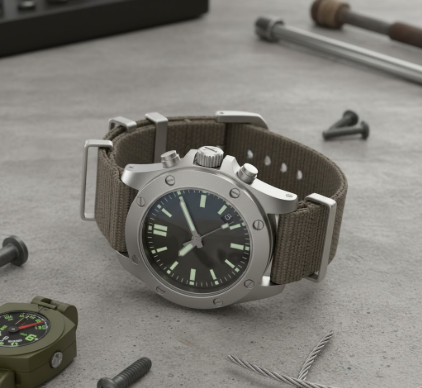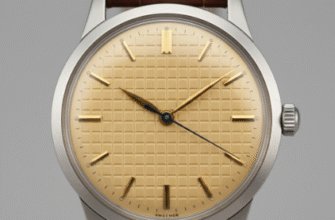The rugged, no-nonsense watch on your wrist might have a more dramatic history than you think. Its durability, legibility, and reliability probably weren’t born in a Swiss design studio’s brainstorming session. Instead, its core DNA was likely forged in the crucible of conflict, dictated by strict military standards designed to ensure performance when failure was not an option. The journey from the battlefield to the boardroom is a fascinating tale of how military specification, or
MIL-SPEC, fundamentally shaped the robust tool watches we admire and wear today.
Before World War I, the wristwatch was largely a delicate piece of women’s jewelry. Men carried pocket watches, but the grim realities of trench warfare quickly made fumbling for a watch in a pocket impractical and dangerous. Soldiers began strapping their pocket watches to their wrists using leather holders, creating crude but effective “trench watches.” Military commanders recognized the urgent need for a more permanent solution. Synchronizing attacks and coordinating artillery required precise, accessible timekeeping for every soldier. This battlefield necessity accelerated the evolution and mass production of the purpose-built men’s wristwatch.
As technology advanced through World War II and into the Cold War, the requirements for military equipment became more formalized. This is where the concept of
MIL-SPEC came into play. These weren’t just vague guidelines; they were hyper-specific documents issued by departments of defense, most notably that of the United States. A standard like
MIL-W-46374, for instance, didn’t just ask for a “durable watch.” It dictated everything from the case material and dimensions to the type of luminous paint on the hands, the accuracy of the movement, and even the font of the numerals on the dial. The goal was simple: to produce a uniform, reliable, and easily serviceable piece of equipment that could withstand the rigors of combat.
This function-first philosophy, driven by military need, gave birth to many of the features we now consider hallmarks of a tough, practical watch. The design wasn’t about aesthetics; it was about survival and efficiency. Every single element had a purpose, a reason for being, which ironically created a timeless and appealing aesthetic of its own.
The DNA of a Tough Watch: Key MIL-SPEC Features
Built to Survive: Durability and Shock Resistance
A soldier’s watch has to endure bumps, drops, and vibrations far beyond what a civilian timepiece might encounter. MIL-SPEC standards demanded cases made from robust materials like
stainless steel, often with a non-reflective, matte or parkerized finish to prevent glinting that could give away a position. The crystals were typically made of acrylic (like Hesalite) rather than mineral or sapphire glass. While more prone to scratching, acrylic is shatter-resistant; it will crack or craze under severe impact but won’t send dangerous shards flying. Lugs were often fixed bars, not the spring bars common today. A nylon pass-through strap (the precursor to the NATO strap) would be threaded through these fixed bars, ensuring that even if one side of the strap failed, the watch head would remain secured to the wrist.
Sealed Against the Elements: Water and Dust Resistance
Military operations occur in every environment imaginable, from dusty deserts to humid jungles and amphibious landings. Keeping the delicate inner workings of the watch movement safe from moisture and fine particles was paramount. MIL-SPEC watches led to the widespread adoption of features like screw-down case backs and crowns, which used gaskets to create a tight seal. This focus on ingress protection was a direct precursor to the development of the specialized civilian
dive watch. The fundamental technology that keeps your Seiko SKX or Rolex Submariner dry at 200 meters has its roots in the military’s demand for a watch that could survive a river crossing.
The MIL-W-46374 standard, first published in 1964, became the foundational specification for U.S. military field watches for decades. It went through several revisions, from A through G, evolving to include different movement types and case materials. Many iconic field watches from brands like Hamilton, Benrus, and Marathon were produced under this very standard.
Clarity Under Fire: Ultimate Legibility
In a low-light situation or at a quick glance, a soldier needs to read the time instantly. MIL-SPEC standards were uncompromising on legibility. This resulted in the classic military dial aesthetic: a high-contrast design, typically a black dial with bold, white Arabic numerals. The hands were simple and distinct, often in a “sword” or “syringe” style. Most importantly, these elements were treated with
luminous material. Early watches used dangerously radioactive Radium paint, later replaced by the less hazardous Tritium (often indicated by an “H3” and a radiation symbol on the dial), and finally giving way to the modern, non-radioactive photoluminescent compounds like Super-LumiNova used in virtually all civilian watches today. Another crucial feature was the “hacking” or stop-seconds function. Pulling the crown out would stop the seconds hand, allowing a whole unit to synchronize their watches to the exact same second before a mission—an absolutely critical function for coordinated operations.
From the Barracks to the Boardroom: The Civilian Crossover
When servicemen returned home, they brought their tough, reliable service watches with them. The watches became a symbol of adventure, competence, and rugged masculinity. The civilian market took notice. The public developed an appetite for these no-frills, highly functional timepieces. This demand sparked a fundamental shift in the watch industry, leading to the creation of the “tool watch” category.
The core principles of a MIL-SPEC watch—durability, water resistance, and legibility—became the blueprint for some of the most iconic civilian watches ever made. The Blancpain Fifty Fathoms and Rolex Submariner, pioneers of the modern dive watch, were heavily influenced by the needs of military combat divers. The IWC Mark series of pilot’s watches are direct descendants of the timepieces they supplied to the Royal Air Force. Perhaps the most direct link is the ubiquitous
field watch. Brands like Hamilton, which was a major supplier to the U.S. military, leveraged that heritage to create civilian lines like the Khaki Field, which remains incredibly popular today for its faithful adherence to the classic military design language.
The Enduring Legacy in Modern Timepieces
The influence is not just a thing of the past. It’s alive and well. Watch enthusiasts cherish the clean, purposeful aesthetic born from military necessity. Many microbrands and established luxury brands alike continue to produce watches that are either direct homages to historical military pieces or are heavily inspired by their design ethos. Features like matte-finished cases, high-contrast dials with large numerals, sword hands, NATO straps, and an emphasis on lume are all part of the MIL-SPEC legacy. When you buy a modern watch celebrated for its robustness and clarity, you are, in essence, benefiting from decades of field-testing and refinement driven by the most demanding circumstances imaginable. The humble military watch proved that exceptional design often arises not from the pursuit of beauty, but from the uncompromising demand for function. It’s a lesson that has shaped the watches we trust and wear every single day, a quiet testament to a history written not in boardrooms, but on battlefields.









